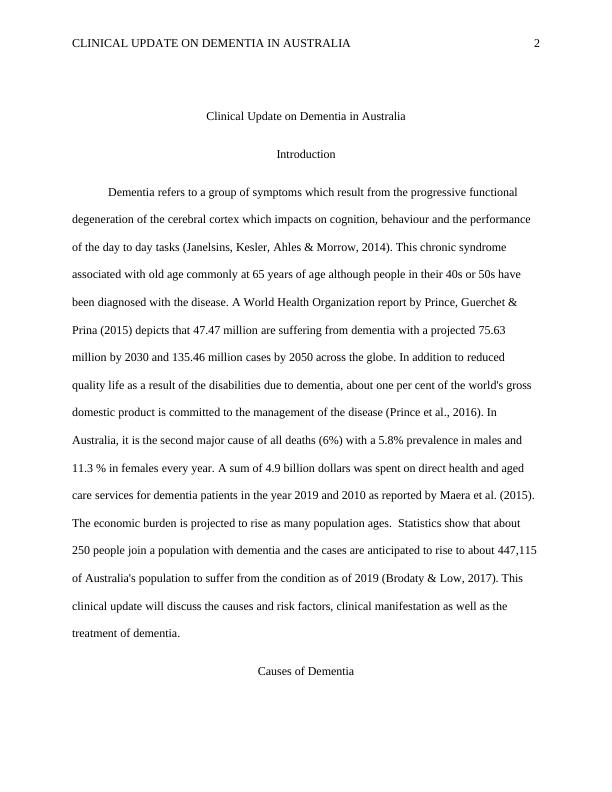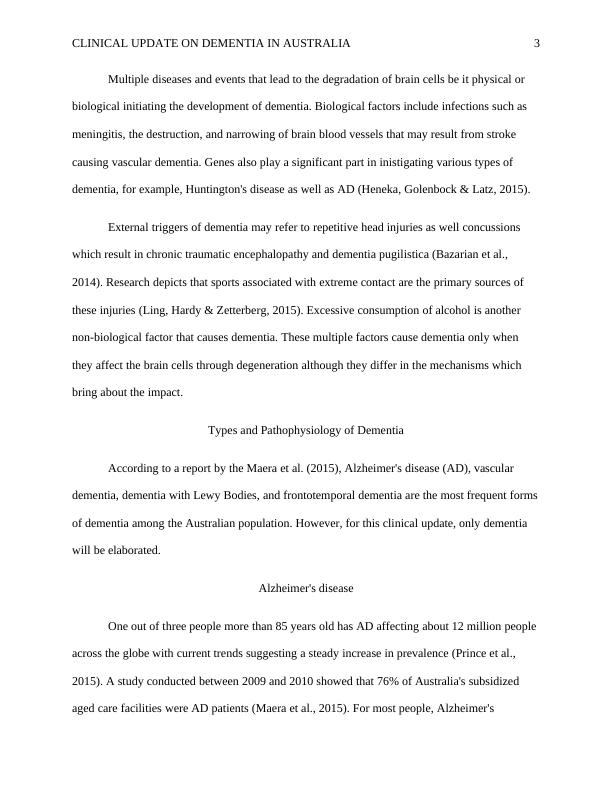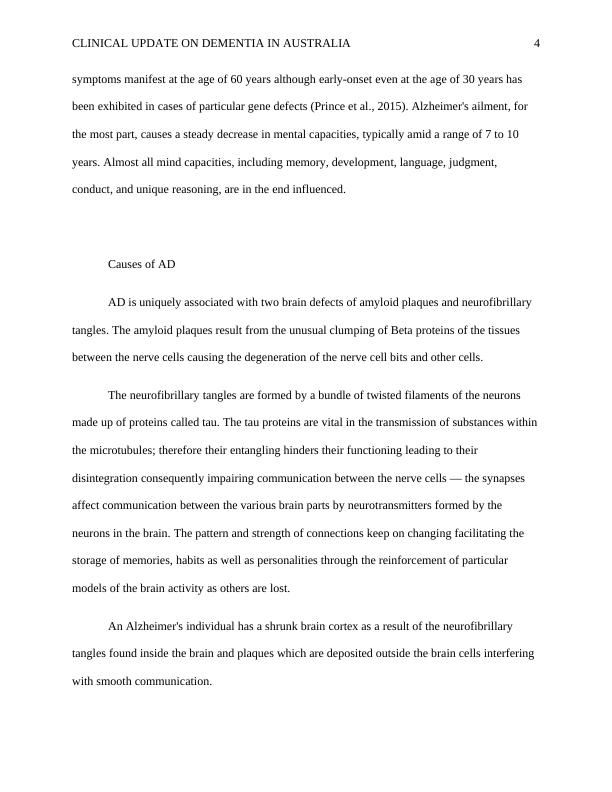Clinical Update on Dementia in Australia
Added on 2022-11-29
14 Pages3768 Words345 Views
Running head: CLINICAL UPDATE ON DEMENTIA IN AUSTRALIA 1
Clinical Update on Dementia in Australia
Name
Institution
Course
Date
Clinical Update on Dementia in Australia
Name
Institution
Course
Date

CLINICAL UPDATE ON DEMENTIA IN AUSTRALIA 2
Clinical Update on Dementia in Australia
Introduction
Dementia refers to a group of symptoms which result from the progressive functional
degeneration of the cerebral cortex which impacts on cognition, behaviour and the performance
of the day to day tasks (Janelsins, Kesler, Ahles & Morrow, 2014). This chronic syndrome
associated with old age commonly at 65 years of age although people in their 40s or 50s have
been diagnosed with the disease. A World Health Organization report by Prince, Guerchet &
Prina (2015) depicts that 47.47 million are suffering from dementia with a projected 75.63
million by 2030 and 135.46 million cases by 2050 across the globe. In addition to reduced
quality life as a result of the disabilities due to dementia, about one per cent of the world's gross
domestic product is committed to the management of the disease (Prince et al., 2016). In
Australia, it is the second major cause of all deaths (6%) with a 5.8% prevalence in males and
11.3 % in females every year. A sum of 4.9 billion dollars was spent on direct health and aged
care services for dementia patients in the year 2019 and 2010 as reported by Maera et al. (2015).
The economic burden is projected to rise as many population ages. Statistics show that about
250 people join a population with dementia and the cases are anticipated to rise to about 447,115
of Australia's population to suffer from the condition as of 2019 (Brodaty & Low, 2017). This
clinical update will discuss the causes and risk factors, clinical manifestation as well as the
treatment of dementia.
Causes of Dementia
Clinical Update on Dementia in Australia
Introduction
Dementia refers to a group of symptoms which result from the progressive functional
degeneration of the cerebral cortex which impacts on cognition, behaviour and the performance
of the day to day tasks (Janelsins, Kesler, Ahles & Morrow, 2014). This chronic syndrome
associated with old age commonly at 65 years of age although people in their 40s or 50s have
been diagnosed with the disease. A World Health Organization report by Prince, Guerchet &
Prina (2015) depicts that 47.47 million are suffering from dementia with a projected 75.63
million by 2030 and 135.46 million cases by 2050 across the globe. In addition to reduced
quality life as a result of the disabilities due to dementia, about one per cent of the world's gross
domestic product is committed to the management of the disease (Prince et al., 2016). In
Australia, it is the second major cause of all deaths (6%) with a 5.8% prevalence in males and
11.3 % in females every year. A sum of 4.9 billion dollars was spent on direct health and aged
care services for dementia patients in the year 2019 and 2010 as reported by Maera et al. (2015).
The economic burden is projected to rise as many population ages. Statistics show that about
250 people join a population with dementia and the cases are anticipated to rise to about 447,115
of Australia's population to suffer from the condition as of 2019 (Brodaty & Low, 2017). This
clinical update will discuss the causes and risk factors, clinical manifestation as well as the
treatment of dementia.
Causes of Dementia

CLINICAL UPDATE ON DEMENTIA IN AUSTRALIA 3
Multiple diseases and events that lead to the degradation of brain cells be it physical or
biological initiating the development of dementia. Biological factors include infections such as
meningitis, the destruction, and narrowing of brain blood vessels that may result from stroke
causing vascular dementia. Genes also play a significant part in inistigating various types of
dementia, for example, Huntington's disease as well as AD (Heneka, Golenbock & Latz, 2015).
External triggers of dementia may refer to repetitive head injuries as well concussions
which result in chronic traumatic encephalopathy and dementia pugilistica (Bazarian et al.,
2014). Research depicts that sports associated with extreme contact are the primary sources of
these injuries (Ling, Hardy & Zetterberg, 2015). Excessive consumption of alcohol is another
non-biological factor that causes dementia. These multiple factors cause dementia only when
they affect the brain cells through degeneration although they differ in the mechanisms which
bring about the impact.
Types and Pathophysiology of Dementia
According to a report by the Maera et al. (2015), Alzheimer's disease (AD), vascular
dementia, dementia with Lewy Bodies, and frontotemporal dementia are the most frequent forms
of dementia among the Australian population. However, for this clinical update, only dementia
will be elaborated.
Alzheimer's disease
One out of three people more than 85 years old has AD affecting about 12 million people
across the globe with current trends suggesting a steady increase in prevalence (Prince et al.,
2015). A study conducted between 2009 and 2010 showed that 76% of Australia's subsidized
aged care facilities were AD patients (Maera et al., 2015). For most people, Alzheimer's
Multiple diseases and events that lead to the degradation of brain cells be it physical or
biological initiating the development of dementia. Biological factors include infections such as
meningitis, the destruction, and narrowing of brain blood vessels that may result from stroke
causing vascular dementia. Genes also play a significant part in inistigating various types of
dementia, for example, Huntington's disease as well as AD (Heneka, Golenbock & Latz, 2015).
External triggers of dementia may refer to repetitive head injuries as well concussions
which result in chronic traumatic encephalopathy and dementia pugilistica (Bazarian et al.,
2014). Research depicts that sports associated with extreme contact are the primary sources of
these injuries (Ling, Hardy & Zetterberg, 2015). Excessive consumption of alcohol is another
non-biological factor that causes dementia. These multiple factors cause dementia only when
they affect the brain cells through degeneration although they differ in the mechanisms which
bring about the impact.
Types and Pathophysiology of Dementia
According to a report by the Maera et al. (2015), Alzheimer's disease (AD), vascular
dementia, dementia with Lewy Bodies, and frontotemporal dementia are the most frequent forms
of dementia among the Australian population. However, for this clinical update, only dementia
will be elaborated.
Alzheimer's disease
One out of three people more than 85 years old has AD affecting about 12 million people
across the globe with current trends suggesting a steady increase in prevalence (Prince et al.,
2015). A study conducted between 2009 and 2010 showed that 76% of Australia's subsidized
aged care facilities were AD patients (Maera et al., 2015). For most people, Alzheimer's

CLINICAL UPDATE ON DEMENTIA IN AUSTRALIA 4
symptoms manifest at the age of 60 years although early-onset even at the age of 30 years has
been exhibited in cases of particular gene defects (Prince et al., 2015). Alzheimer's ailment, for
the most part, causes a steady decrease in mental capacities, typically amid a range of 7 to 10
years. Almost all mind capacities, including memory, development, language, judgment,
conduct, and unique reasoning, are in the end influenced.
Causes of AD
AD is uniquely associated with two brain defects of amyloid plaques and neurofibrillary
tangles. The amyloid plaques result from the unusual clumping of Beta proteins of the tissues
between the nerve cells causing the degeneration of the nerve cell bits and other cells.
The neurofibrillary tangles are formed by a bundle of twisted filaments of the neurons
made up of proteins called tau. The tau proteins are vital in the transmission of substances within
the microtubules; therefore their entangling hinders their functioning leading to their
disintegration consequently impairing communication between the nerve cells — the synapses
affect communication between the various brain parts by neurotransmitters formed by the
neurons in the brain. The pattern and strength of connections keep on changing facilitating the
storage of memories, habits as well as personalities through the reinforcement of particular
models of the brain activity as others are lost.
An Alzheimer's individual has a shrunk brain cortex as a result of the neurofibrillary
tangles found inside the brain and plaques which are deposited outside the brain cells interfering
with smooth communication.
symptoms manifest at the age of 60 years although early-onset even at the age of 30 years has
been exhibited in cases of particular gene defects (Prince et al., 2015). Alzheimer's ailment, for
the most part, causes a steady decrease in mental capacities, typically amid a range of 7 to 10
years. Almost all mind capacities, including memory, development, language, judgment,
conduct, and unique reasoning, are in the end influenced.
Causes of AD
AD is uniquely associated with two brain defects of amyloid plaques and neurofibrillary
tangles. The amyloid plaques result from the unusual clumping of Beta proteins of the tissues
between the nerve cells causing the degeneration of the nerve cell bits and other cells.
The neurofibrillary tangles are formed by a bundle of twisted filaments of the neurons
made up of proteins called tau. The tau proteins are vital in the transmission of substances within
the microtubules; therefore their entangling hinders their functioning leading to their
disintegration consequently impairing communication between the nerve cells — the synapses
affect communication between the various brain parts by neurotransmitters formed by the
neurons in the brain. The pattern and strength of connections keep on changing facilitating the
storage of memories, habits as well as personalities through the reinforcement of particular
models of the brain activity as others are lost.
An Alzheimer's individual has a shrunk brain cortex as a result of the neurofibrillary
tangles found inside the brain and plaques which are deposited outside the brain cells interfering
with smooth communication.

End of preview
Want to access all the pages? Upload your documents or become a member.
Related Documents
Dementia: Understanding the Symptoms, Risk Factors, and Managementlg...
|7
|4666
|172
Pathophysiology of Dementia Assignment 2022lg...
|12
|3574
|10
HNB3209 - Report on Nursing and The Communitylg...
|12
|3009
|98
Alzheimer Disease: Clinical Updatelg...
|13
|3277
|403
Clinical Reasoning Cycle Case Study for Nursing Professionalslg...
|10
|2625
|95
Case Study on Global Burden of Diseaselg...
|13
|3353
|14
